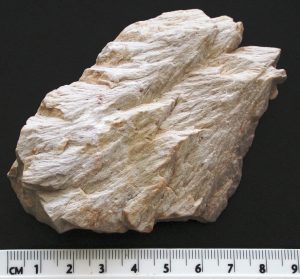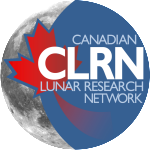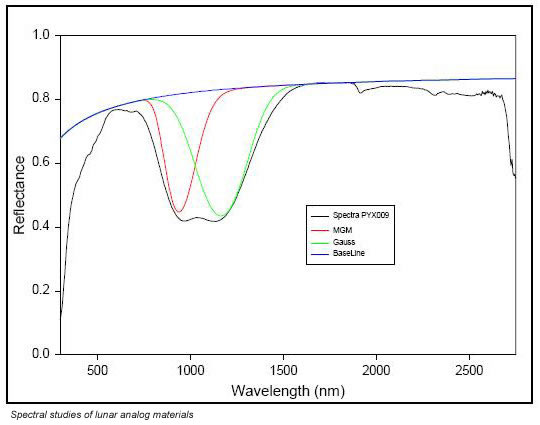The overall goal of the CLRN’s research on lunar meteorites, Apollo samples and terrestrial analogue materials is to understand the effect of shock on lunar materials. Several CLRN researchers are examining lunar meteorites and rock samples, and terrestrial impactites for evidence of shock deformation of minerals via reflectance spectroscopy, in situ micro-XRD, Raman spectroscopy, scanned electron microscopy (SEM), and SEM-cathodoluminescence (CL). Other research focuses on understanding bulk physical properties of lunar meteorites (e.g., density, porosity, magnetic susceptibility, and magnetic remanence) for the purpose of determining these objects’ bulk responses to impact events, thermal changes, paleomagnetic fields, cosmic ray irradiation and passage through the atmosphere as meteors.
In addition, part of the overall goal is to support the analysis of lunar spectroscopic data, whether acquired by earth- or space-based telescopes, orbiters or landers. Dr. Cloutis at the University of Winnipeg has been looking at the ultraviolet spectral properties of terrestrial analogues of lunar minerals, and the use of ultraviolet observations for lunar mapping (particularly of oxides). In 2018, Dr. Cloutis received approval from the NASA Astromaterials Curator for the loan of six pristine 1-gram samples of lunar soils (highlands, low-Ti mare, high-Ti mare). Dr. Cloutis, along with his collaborators, are currently characterizing these samples by reflectance spectroscopy from the ultraviolet to the infrared (0.2-16 microns) and generating mineral separates to characterize the major phases (olivine, plagioclase feldspar, pyroxene, oxides). The goal is to determine the spectral properties of pristine lunar samples, particularly in the ultraviolet, where even trace amounts of ferric iron (expected to be absent in the pristine samples, but which may form during even short exposures to the terrestrial environment) can affect the ultraviolet spectral properties.

Example of a shock metamorphosed feature. Shatter cones in a fine-grained dolomite from Wells Creek crater, TN, USA.
Lunar samples and soil have distinctive magnetic properties linked to the presence of free FeNi metal, FeSi and nanophase iron. The nanophase iron is a major darkening agent in agglutinates, a product of space weathering due in part to micrometeoroid bombardment. Magnetic measurements offer a means of quantifying the presence and effective grain size of metal in lunar soils and can be used as an index of shock metamorphism in lunar samples and meteorites as effective metal grain size increases with shock state. The spectral properties of mafic minerals mixed with nanophase iron this summer will also be studied by Dr. Cloutis and colleagues.
Several CLRN members are seeking to understand how impact craters produce superheated melt deposits and shock targets on planetary surfaces. Led by Dr. Gordon Osinski, a research team at Western University studies the mineralogy, shock state, and P-T conditions of impactite samples collected from various impact structures from across Canada, including Mistastin Lake (Labrador), West and East Clearwater (Quebec), Brent (Ontario), and Haughton (Nunavut). The target rock is largely plagioclase feldspar, and hence provides an excellent terrestrial analogue for the effects of impact events on the lunar surface. Dr Osinski and his team focus primarily on Mistastin Lake, since the target rocks surrounding the impact structure are chemically and petrographically analogous to the lunar crust. A recent publication from his team confirmed the high superheated temperatures of impact melt at Mistastin Lake (paper), supporting research that was published by Timms et al., 2017.
CLRN researchers are also working to address the dynamics of ejected lunar dust. Our goal is to examine in detail the delivery of lunar dust from impacts of all sizes between the Moon and Earth. Numerical integration of the equations of motion, coupled with an ejection model and treatment of Lorentz forces is to be included. This will address the issue of ocean sediment He3 flux variations and if these could be due largely to lunar impacts alone. Furthermore, because the Moon is airless, material is easily ejected, but material on sub-orbital ballistic trajectories are also free to disperse across the surface. This results in secondary and possibly tertiary craters. Ongoing investigations include the effects of lunar impact flashes in terms of their ejecta. Although the impactors are relatively small, they could excavate a considerable amount of material that could form a short-lived dust plume as it disperses across the surface. This is of interest from a safety point of view in terms of the possibility of human lunar exploration.
References
- Timms, N. E., Erickson, T. M., Zanetti, M. R., Pearce, M. A., Cayron, C., Cavosie, A. J., … & Carpenter, P. K. (2017). Cubic zirconia in> 2370° C impact melt records Earth’s hottest crust. Earth and Planetary Science Letters, 477, 52-58.


